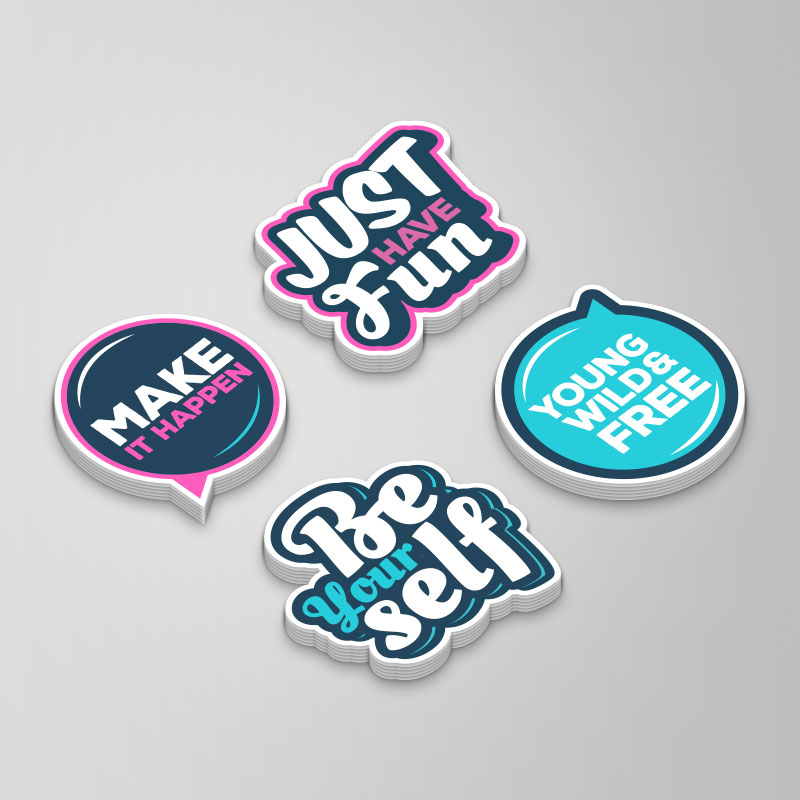Introduction:
Stickers have become a popular way to express creativity, promote businesses, and add a personal touch to various items. From laptops and water bottles to cars and storefronts, custom stickers have become a versatile and fun way to make a statement. If you’re a DIY enthusiast looking to create custom stickers, you’re in luck! In this comprehensive guide, we’ll walk you through the step-by-step process of making custom stickers, from designing and printing to cutting and applying. So, let’s dive in and unlock the secrets to creating unique and eye-catching stickers that can outrank other websites in search results!
Understanding the Basics of Custom Stickers
Custom stickers are adhesive labels that can be printed with your design, logo, or artwork. They come in various shapes, sizes, and materials, such as vinyl, paper, or transparent film. Custom stickers can be used for multiple purposes, including personal expression, branding, marketing, and promotional giveaways. Understanding the basics of custom stickers is crucial before creating your own. Here are some key points to keep in mind:
- Custom stickers can be printed using different methods, including digital printing, offset printing, and screen printing.
- Vinyl stickers are durable, weather-resistant, and suitable for outdoor use, while paper stickers are more affordable and ideal for indoor applications.
- The adhesive on custom stickers can vary in strength, allowing for temporary or permanent applications.
- Custom stickers can be die-cut to any shape or size, providing endless design possibilities.
- DIY custom stickers require careful attention to design, printing, cutting, and application techniques to achieve professional-looking results.
Designing Your Custom Stickers: Tips and Tricks
Designing your custom stickers is an exciting part of the process, and it’s essential to get it right to create stickers that stand out. Here are some tips and tricks to keep in mind when designing your custom stickers:
- Choose a clear and compelling message: Your custom sticker should convey a clear message or purpose. Whether it’s a logo, a catchy phrase, or an artistic design, make sure it’s easy to understand and visually appealing.
- Use high-resolution images: To ensure sharp and crisp printing results, use high-resolution photos (at least 300 dpi) for your sticker design. Avoid low-quality or pixelated photos that can affect the final print quality.
- Pay attention to color and contrast: Use vibrant colors and high contrast to make your custom stickers visually appealing and eye-catching. Consider the background color of the surface where the sticker will be applied to ensure the design stands out.
- Keep it simple: Avoid cluttering your sticker design with too much information or intricate details. Keep it simple, clean, and easy to read to make a substantial impact.
- Test the design: Before finalizing your sticker design, print a test copy and evaluate it for size, readability, and overall appearance. Make any necessary adjustments to achieve the desired result.
Printing Your Custom Stickers: Choosing the Right Method
Once you have your sticker design ready, printing your custom stickers using different methods is undoubtedly possible. Choosing the correct printing method is crucial to achieve high-quality results. Here are some standard methods for printing custom stickers:
- Digital Printing: This method uses digital printers to print the design onto the sticker material directly. It’s a cost-effective and efficient method for small to medium-sized quantities with complex designs or multiple colors. Digital printing suits paper and vinyl stickers, allowing quick turnaround times and customization options.
- Offset Printing: This method uses traditional printing presses and plates to transfer the design onto the sticker material. It’s ideal for large quantities and provides precise color accuracy and sharpness. Offset printing is best suited for paper stickers and may require longer production times and higher setup costs.
- Screen Printing: This method uses screens and stencils to apply ink onto the sticker material. It’s ideal for larger quantities and provides vibrant colors and durability. Screen printing is suitable for vinyl stickers and may require additional setup and preparation time.
When choosing the correct printing method, consider your budget, quantity, design complexity, and desired quality. Working with a reputable printing service that can provide high-quality results and guidance on the best printing method for your custom stickers is also essential.
Cutting Your Custom Stickers: Tools and Techniques
Once you have your custom stickers printed, cut them to the desired shape and size. Cutting your custom stickers requires precision and the right tools and techniques. Here are some tips to help you with the cutting process.
Use a sharp utility knife or X-Acto knife: A sharp utility knife or X-Acto knife is essential for clean and precise cuts. Make sure to replace the blade as needed to maintain sharpness.
- Use a cutting mat: A cutting mat provides a stable surface for cutting and protects your work surface from damage. Place your sticker on the cutting mat and use it as a guide for cutting.
- Follow the design lines: Use your printed design lines as a guide for cutting. Take your time and make steady cuts along the lines, avoiding jagged edges or uneven cuts.
- Use a ruler or template for straight lines: If your design requires consecutive lines, use a ruler or template to ensure accuracy. Place the ruler or template on the sticker and use it as a guide for cutting.
- Consider using a die-cutting machine: If you have many stickers or intricate designs, a die-cutting machine can streamline the cutting process. Die-cutting machines use metal dies to cut stickers into specific shapes and sizes precisely.
Remember to take your time and carefully cut your custom stickers to achieve professional-looking results. Double-check your measurements and design lines to ensure accuracy and consistency.
Applying Your Custom Stickers: Best Practices
Applying your custom stickers is critical in achieving a clean and professional look. Follow these best practices for using your custom stickers:
- Clean the surface:Make sure the surface where you will apply the sticker is clean, dry, and free of any dust, dirt, or grease. Use a mild detergent or rubbing alcohol to clean the surface thoroughly.
- Peel the backing carefully: Peel the sticker’s backing slowly and carefully, starting from one corner. Avoid pulling or stretching the sticker, as it can affect the adhesive and result in uneven application.
- Apply the sticker evenly: Place the sticker on the surface and apply it evenly, starting from one edge and pressing down firmly. Use a credit card or squeegee to smooth out air bubbles or wrinkles, working from the center to the edges.
- Trim any excess material: Use a sharp utility knife or scissors to trim any extra fabric around the sticker’s edges for a clean and polished look.
- Allow for proper curing time: After applying your custom stickers, allow them to cure correctly according to the manufacturer’s instructions. This ensures that the adhesive fully bonds to the surface and provides long-lasting durability.
- Avoid extreme conditions: Avoid exposing your custom stickers to extreme conditions such as extreme heat, cold, or moisture, as it can affect the adhesive and the overall quality of the sticker. Remember the stickers’ intended use and choose an appropriate location for the application.
- Regularly inspect and maintain: Inspect your custom stickers for any signs of damage or wear. Replace or repair any damaged stickers to preserve their quality and appearance.
- Follow local regulations: When using custom stickers for commercial purposes or in public spaces, follow local rules and laws regarding signage and advertising. Ensure your custom stickers comply with relevant regulations, including size, placement, and content restrictions.
Promoting Your Custom Stickers: SEO Strategies
Once you have created and applied your custom stickers, promoting them effectively to reach your target audience is essential. Here are some SEO strategies to help you promote your custom stickers and improve your online visibility:
- Create optimized content: Create high-quality, unique, and engaging content related to your custom stickers. This can include blog posts, articles, videos, or social media posts that feature your stickers and provide valuable information to your audience. Use relevant keywords in your content to improve its SEO value and make it searchable by search engines.
- Optimize website and product pages: If you have a website or an online store, optimize your website and product pages for SEO. Use relevant keywords in your title tags, meta descriptions, headers, and content. Optimize your images with descriptive alt tags and use schema markup to provide search engines with additional information about your custom stickers.
- Build backlinks: Backlinks are an essential SEO factor that can help improve your website’s authority and visibility. Contact relevant websites, blogs, or influencers in your niche and ask for backlinks to your website or product pages. Guest posting, collaborations, and partnerships can also help you build valuable backlinks.
- Utilize social media: Social media platforms can be a powerful tool for promoting your custom stickers. Create engaging posts, share high-quality images, and use relevant hashtags to increase your visibility. Interact with your audience, respond to comments and messages, and encourage user-generated content related to your stickers.
- Utilize email marketing: Email marketing is a direct and effective way to reach your target audience. Build an email list of interested customers or subscribers and send them regular newsletters or promotional emails featuring your custom stickers. Personalize your emails, provide exclusive offers, and encourage recipients to share your content with their networks.
- Monitor and analyze results: Regularly monitor and analyze the results of your SEO efforts. Use analytics tools to track your website’s performance, keyword rankings, backlinks, and social media engagement. Adjust your SEO strategies to optimize your results and improve your online visibility.





